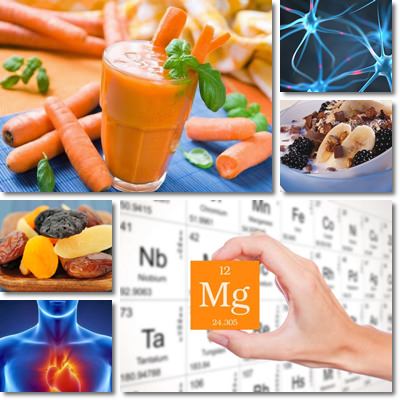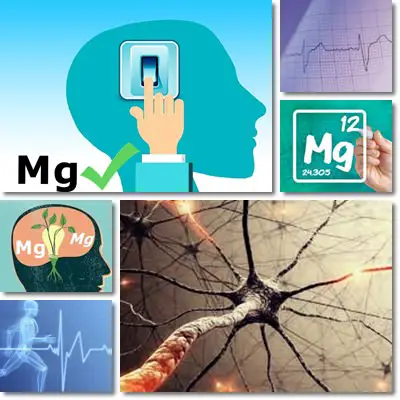Magnesium is an essential dietary mineral found in generous amounts in green leafy vegetables such as spinach, nuts and seeds such as almonds and pumpkin seeds and several other foods.
Having a sufficient intake from food sources and dietary supplements contributes to stronger bones, a healthy heart, good blood circulation, regulates heart rhythm, ensures an overall good muscle function and nerve health, and supports mental health. But not all magnesium is the same. Some forms of the nutrient are actually better absorbed than others.
The amount of magnesium we absorb from one form or another dictates just how good the respective form of the mineral is for us.
Naturally, we should go for the best forms, meaning those our body absorbs the most of.
While we only take in 10 or 20% of most forms of magnesium, others may have an absorption rate of 50 or 60%, making them superior in quality and more likely to improve our health.
So choosing the best form of magnesium in order to ensure the highest absorption rate possible is important if we want to enjoy all the health benefits the mineral has to offer.

What are the benefits of taking magnesium?
We take magnesium for muscle cramps and spasms such as painful calf cramps, foot cramps and leg cramps at night, thigh twitching, cramps under the chin, eyelid twitching and muscle tremors.
We take magnesium to increase the absorption of calcium in bones and teeth, build bone and help create new bone tissue.
Magnesium supplements help with palpitations, extrasystoles and other forms of arrhythmia and cardiovascular manifestations.
Taking magnesium at night helps relieve insomnia and favors better sleep, improves mood and so many other symptoms and complaints.
Despite its apparently minor benefits for health, magnesium is an essential nutrient with a powerful impact on the nervous, cardiovascular, muscular and even digestive system, as well as mental health.
Research shows it is involved in over 350 chemical reactions within the human body and its presence in the body is of crucial importance for basic cellular processes.
Magnesium deficiency has been shown to contribute to and accentuate conditions such as fibromyalgia, cardiovascular disease, osteoporosis, diabetes, anxiety, depression and chronic fatigue syndrome, to name just a few.
Intensive agricultural practices depleting soil of essential nutrients which, in turn, leaves food less nutritious than it used to be, taking antacids, proton pump inhibitors and other medication that reduce stomach acidity to improve gastroesophageal reflux disease and treat gastritis, taking antidepressants or diuretics, malabsorption problems and other digestive conditions and, of course, a bad diet all deplete the body’s magnesium reserves with unfortunately quantifiable side effects for multiple systems and organs.
Not just this, but chronic stress, sleep deprivation, physical effort from manual labor, practicing a sport, cognitive effort resulting from studying, and existing health issues such as anxiety, depression, high blood pressure, extrasystoles, palpitations etc. often increase demands of the mineral.
What to know about taking magnesium
When looking to increase your magnesium intake and enjoy the benefits for health it provides, there are multiple factors to consider in addition to choosing the right form of magnesium.
To better understand magnesium metabolism, it’s good to know the following facts:
- The amount of magnesium the body can physically absorb is different from person to person. For example, existing malabsorption problems reduce absorption of nutrients.
- Then there is the competitiveness of other nutrients: calcium, copper, iron, manganese, phosphorus may compete with and reduce magnesium absorption. Other nutrients may favor it.
- Some nutrients increase or facilitate magnesium absorption. For example, vitamin D helps increase magnesium uptake.
- Dietary and lifestyle factors matter. Alcohol, coffee and caffeine-rich foods or beverages such as green tea or dark chocolate can deplete magnesium reserves; soft drinks too.
- Cooking practices matter. For example, soaking grains makes their nutrients more bioavailable, magnesium included. Cooking certain foods such as spinach reduces their oxalic acid content and, because oxalic acid reduces nutrient absorption in the gastrointestinal tract, reducing its levels in food favors nutrient uptake, magnesium included.
- Unusually increased demands of the mineral, caused by stress or disease, paired with an insufficient intake are enough to produce a severe deficiency with measurable side effects.

But the factor that weighs most heavily when it comes to which magnesium form to choose is the absorption rate of the different types of the mineral. Considering its wide range of action and vital involvement in so many aspects of health, knowing which type of magnesium to take is crucial if you want to enjoy the many health benefits the supplement provides.
So what makes one form of magnesium healthier than another? Its absorbance rate or how much of it our body successfully absorbs. This being said, see below what are the most and least helpful magnesium forms to take.
Magnesium forms: benefits, side effects, absorption rate
1) Magnesium oxide
This form is often prescribed for the treatment of duodenal and gastric ulcers, indigestion and gastroesophageal reflux due to its basic nature. It is also a strong laxative, hence its use for relieving constipation. However, taking too much can result in diarrhea and digestive upset.
Magnesium oxide has a very poor gastrointestinal absorption rate, in certain individuals being significantly lower than 10%, usually around 4%. Surprisingly, many multivitamin and multimineral complex supplements contain this very form of magnesium.
2) Magnesium sulfate
This particular form of magnesium is generally for intravenous use and for stopping preterm labor. It can be absorbed, to a certain extent, through the skin and is also the main ingredient in Epsom bath salts.
These salts are added to bath water for the magnesium to be absorbed through the skin and help ease arthritis pain, muscle aches and stiff and swollen joints. Magnesium sulfate typically has a very low absorption rate, but higher than that of oxide.
3) Magnesium citrate
Magnesium citrate has a higher absorption rate than both magnesium oxide and magnesium sulfate and is suggested to be one of the better forms of the mineral in terms of bioavailability (up to 30%).
From my experience, it is a great form of magnesium, quickly absorbed and with fast and visible effects.
It is found in the famous Italian magnesium and potassium dietary supplement Polase. One aspect I’ve noticed when taking this type of magnesium is its effects are not as long-lasting compared to other forms with similarly high or higher bioavailability.
4) Magnesium chloride
This particular form is actually better absorbed by the body than magnesium oxide and is not as strong a laxative as magnesium sulfate, but does loosen stools when taken in larger amounts.
Because chloride is involved in the production of hydrochloric acid and thus influences digestion and nutrient absorption, it is believed to be a great option for people who do not produce sufficient stomach acid.
Not having sufficient stomach acid means that we don’t digest food as we should, so we don’t absorb as much of nutrients from food either.
5) Magnesium carbonate
The consensus is that magnesium carbonate has one of the lowest absorption rate of all forms, thus being one of the cheapest and least helpful options when looking to prevent or correct a deficiency.
It is estimated that it has an absorption rate of less than 10%, though some studies suggest its bioavailability may be as high as 20%.
Overall, it is not the best form and exhibits laxative properties when taken in large amounts or over prolonged periods of time. It does however make a great antacid.
Personal note:
Despite its low absorption rate, I have taken magnesium carbonate supplements (150 milligrams dose or 300 milligrams dose of magnesium carbonate a day) and had great results with it.
I experienced an almost instant feeling of calm and visibly reduced anxiety. In all honesty, this magnesium is good for the nerves when taken in a 150 mg or 300 mg dose, depending on the person and circumstances.
Similar doses of of magnesium carbonate are also great for muscle cramps and spasms, high blood pressure and tachycardia initiated by a stressful, upsetting event (as per my experience, it can start bringing down an extremely high resting heart rate in less than 10 minutes).
6) Magnesium aspartate
With a high bioavailability, it is a great form of the mineral. Magnesium aspartate has been used together with potassium for improving and treating chronic fatigue syndrome. There have been warnings against the use of this particular form due to the fact that it is a synthetic product and may engender neurotoxicity, but even so, specific conditions (example: extremely high intakes) would have to be met. Also, aspartic acid is a non-essential amino acid that is also found naturally in food: game, pork, oysters, sprouts and various vegetables and grains.
In my experience, magnesium aspartate is one of the best forms, with almost immediate results and long-lasting beneficial effects. According to the European Food Safety Authority, magnesium aspartate has an absorption rate of 60% and a retention value of 47%, meaning you should absorb as much as 60% and retain as much as 47% of this particular magnesium formulation.
Personal note:
For some time now I have been taking a Romanian brand of dietary supplements called Aspacardin – it contains magnesium aspartate and potassium aspartate in small amounts. Actually, the amounts of magnesium and potassium this particular supplement contains are not even close to the recommended minimum daily intakes for the average adult.
And yet it produces measurable benefits, even though I’ve only taken the minimum recommended amount of the supplement. Starting with the first week I have noticed a significant improvement in my sleep quality and mood.
If find this particular magnesium and potassium supplement great for when you’re in extremely stressful situations because it helps you maintain your calm and enjoy clear thinking, reducing heart rate, stress levels and anxiety. Since I’ve been taking it, I no longer get palpitations or extrasystoles and have enjoyed steady blood pressure numbers (I suffer from low blood pressure).
Also, because I’ve had severe problems with excess stomach acidity from acid reflux, and developed malabsorption issues due to prolonged use of antacids and proton pump inhibitors, I have found great relief in this particular supplement because it has helped me sleep better, wake up better rested both mentally and physically (no more muscle stiffness!), and enjoy excellent energy levels as a result.
Because of its beneficial effects on blood pressure, this potassium and magnesium supplement has helped me no longer experience a fainting sensation when standing. Honestly, it has done wonders for me and, after taking it for about a year on and off now, mostly during more stressful periods of time and at night (really great for sleep), I have noticed I am feeling good even when I am off it for some time.

7) Magnesium gluconate
Magnesium gluconate is believed to be a great choice for correcting magnesium deficiencies.
In the right conditions, this form has a higher bioavailability than citrate and even aspartate.
According to the European Food Safety Authority, magnesium gluconate has an absorption rate of 67% and a retention value of 49%.
But magnesium gluconate may cause diarrhea when taken in high doses.
Also, the gluconic acid with which magnesium is paired is believed to contribute to higher energy levels due to its involvement in glucose (blood sugar) metabolism.
8) Magnesium glycinate
This form combines glycine, an amino acid and neurotransmitter with inhibitory action on the central nervous system with magnesium. This particular form has a sedative effect on the nervous system, induces relaxation and is known to help improve sleep quality and treat insomnia. It holds therapeutic effects for muscle aches and cramps and chronic fatigue syndrome.
It lacks the laxative properties of other forms such as magnesium oxide. However, some people have reported magnesium glycinate may have stimulant effects in certain doses and may thus alter normal sleep patterns.
9) Magnesium malate
Preliminary studies suggest magnesium malate may prove useful in treating fibromyalgia pain.
It generally has a good absorption rate, but it is not as efficient as magnesium citrate or aspartate. There have been reports of it causing loose stools and stomach upset.
Magnesium malate may hold antimicrobial properties and increase saliva production.
10) Magnesium lactate
Magnesium lactate has a good absorption rate and though it is superior to the oxide and sulfate forms and well tolerated, it is not considered the most efficient formula by many sources. This form is estimated to have an average bioavailability of over 10%, but sources such as the European Food Safety Authority put its absorption rate at 59% and retention value at 48%, making it one of the best forms of magnesium with a high bioavailability. Common side effects of taking large doses or prolonged use include digestive discomfort, bloating, flatulence and diarrhea.
11) Magnesium taurate
Taurine is found naturally in the bile and other parts of the digestive system of animals.
Magnesium taurate is a magnesium salt of taurine.
This particular form is suggested to contribute to improved muscle function, hence its cardiovascular benefits (improving the force of heart contractions) and induce relaxation due to taurine’s inhibitory effects on the nervous system.
12) Magnesium orotate
In addition to a good absorption rate, magnesium orotate contributes to increasing resistance to physical exercise and improving heart health, mainly because it is easily taken in the bloodstream.
Just like magnesium taurate, it has a beneficial action when it comes to heart failure.
However, animal research suggests that large doses of around 100 mg per kg per day may encourage tumor formation.
This form is also more pricey than others, making it less desirable than citrate or aspartate, despite its relatively high bioavailability.
13) Magnesium pidolate (picolinate)
Magnesium pidolate has a good absorption rate and is well tolerated by the human body. It is mainly recommended for treating hypomagnesemia (low levels of magnesium) and counteracting a potential deficiency.
This form has also been investigated as a potential treatment for sickle cell anemia.
14) Magnesium-L-threonate
This particular type of magnesium has been shown to have a high absorption rate and good bioavailability. What makes it a good form is the fact that it can easily enter cells and tissues and cross the blood-brain barrier to exert its health effects, particularly support cognitive functions. Moreover, it does not have laxative properties. However, because of its low content of magnesium per dose, it might not be sufficient to correct deficiencies. Important. Magnesium stearate is not a dietary mineral per se, but a sort of additive.
Conclusion
When it comes to magnesium, absorption rates matter. We might be taking a 300 milligram or 400 milligram daily dose of magnesium to meet our demands, yet absorb less than 10% and still have a deficiency, despite supplementing.
When we might be taking a good form of magnesium and absorb most of it, enjoying a visible reduction of magnesium deficiency symptoms and an overall improved health. While other factors need to be taken into account as well, the form of magnesium we choose and its bioavailability and absorption rate do have a significant impact on our health.
